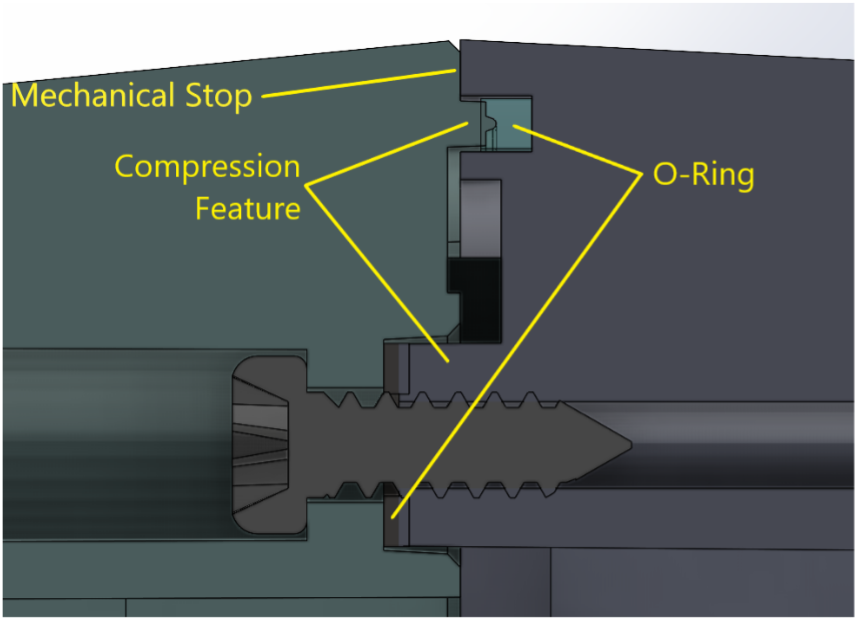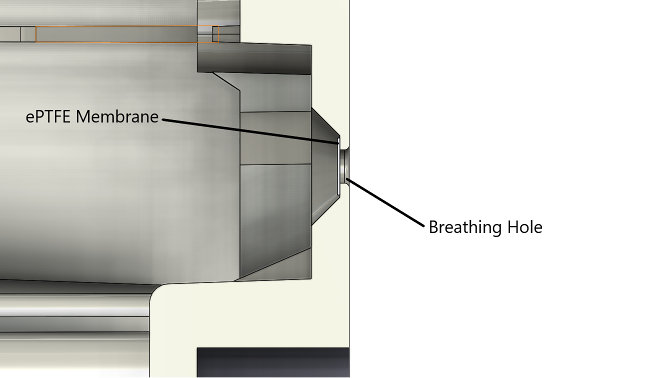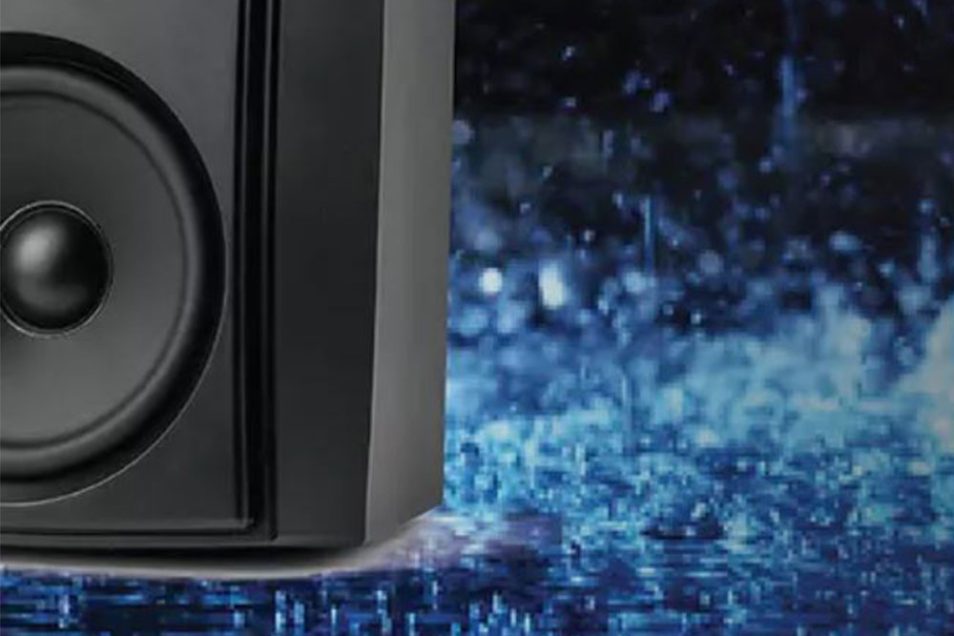Tech Talk
Designing an IP67 Waterproof Speaker
By Erik Lundin, Sr. Mechanical Engineer

1. Introduction to IP Ratings
Ingress Protection ratings use two digits to specify how well a product will withstand certain conditions. The IP code is defined by the International Electrotechnical Commission (IEC) and is used globally both in technical contexts and for marketing.
The first digit specifies the level of protection the enclosure provides from solid particles. It can be 0-6, or an X where there is no data to specify protection.
0.
No protection.
1.
Any large surface of the body (> 50mm / 2in), but no protection against deliberate contact with a body part.
2.
Fingers or similar objects (> 12.5mm / 0.49in)
3.
Tools, thick wires, etc. (> 2.5mm / 0.098in)
4.
Most wires, slender screws, large ants, etc. (> 1 mm / 0.039 in)
5.
Ingress of dust is not entirely prevented, but it must not enter in sufficient quantity to interfere with the safe operation of the equipment.
6.
No ingress of dust. Complete protection against contact.
The second digit specifies the level of protection the enclosure provides from water. It can be 0-9, or an X where there is no data to specify protection. Note that none of these ratings must prevent water from entering the enclosure, only ensure that any water that enters under the testing conditions does not cause any harmful effects.
0.
None
1.
Vertically falling dripping water equivalent to 1mm of rain per minute for ten minutes, while rotating at 1RPM.
2.
Same as 1, but with the product tilted 15° from upright. This should provide good protection from rain.
3.
Spraying water up to 60° from upright, 10 liters per minute for at least 5 minutes, more depending on size.
4.
Same as 3, but from any angle. This should allow the product to be near splashing water.
5.
Water jets from a 6.3mm/0.25in nozzle at 12.5 liters per minute at 30kPa/4.4psi, at a distance of 3 meters for at least 3 minutes, more depending on size.
6.
Same as 5, but double the nozzle size, 100 liters per minute, and a pressure of 100kPa/15psi. This should allow an outdoor product to be hosed off for cleaning.
7.
Immersion in water down to 1 meter/3.25ft for 30 minutes.
8.
Continuous immersion in water down to 1m/3.25ft or more, as defined by the manufacturer.
9.
Protected against close-range high-pressure spray from multiple angles. This involves 14-16 liters per minute of hot water at 8-10MPa of pressure at distances below 0.15 meters.
Additionally, there are a few letters and special cases that can be added to the rating. For example, IPX6K involves higher pressure water jets than IPX6.
The letters A-D specify protection of users from access to hazardous parts of the enclosure with backs of hands, fingers, tools or wires. Additionally, some letters are used to specify protection of the enclosure further.
F.
Oil resistant
H.
High voltage apparatus
M.
Motion during water test
S.
Stationary during water test
W.
Weather conditions
So, to summarize, a product with an IP code of IP67 offers dust protection, and immersion in water up to 1m deep for 30 minutes. IP42 has no holes bigger than 1mm and provides good resistance to rain.
2. Designing for IPX7
Designing products to resist spraying or splashing water is a fairly simple concept. Just make sure there aren’t any gaps or holes and the product will most likely do just fine. Once you get further down the list, however, everything changes. Water droplets resting on a gap need some coaxing to overcome their surface tension. Water droplets being pushed against a gap, however, will always travel in whatever direction has the least resistance. Once an enclosure is immersed in water, the pressure of the water column above the enclosure means that the direction of lowest resistance is into the inside of that enclosure.
Common methods of providing this pressure are rubber o-rings, form-in-place gaskets, glue, and welding. O-rings are frequently stretched around protruding features, or placed into shaped grooves. FIP gaskets are often deposited on flat surfaces which will be pressed against other flat surfaces.
3. The JBL Stage XD Series
The enclosure design of the JBL Stage XD series went through several iterations in the search for an acoustically suitable and aesthetically pleasing shape which could also be sealed against water ingress. The final design was a clam shell design where the tweeter waveguide is molded directly into the baffle side of the enclosure. On the rear, the binding post cup was also molded directly into the rear enclosure half. Minimizing the number of joints which could leak was a primary driving force. This also made our zero-bezel grille an obvious choice, being held in place by magnets. The magnets are installed inside the enclosure and are never exposed to the elements. One half of the clam shell contains a groove which holds a continuous rubber o-ring. The other half has a molded ridge which presses the o-ring against the walls of its groove. The amount this o-ring is compressed is determined by how hard the two pieces of the enclosure are pressed together, which in turn is determined by mechanical stops designed into the parts.
Most of this process was completed in software and verified through simulation. However, validation of the choices made, and of the simulation results, was undertaken by 3D printing the entire enclosure out of ABS plastic in a couple iterations. This allowed us to get a hands-on feel for the sealing methods we had chosen.
Holes were avoided where possible, but some are necessary for the product to function. Obviously, the screws used to hold the two halves of the enclosure together have holes. These screws have their mating surface offset into the part to be very near the mating surface of the enclosure halves themselves. Each screw is sealed with an o-ring and a protruding compression feature. The holes for the safety catch and binding posts, as well as the tweeter, are additionally sealed with a liquid adhesive after installation onto their respective enclosure half.

4. Pressure Equalization
Because a water proof speaker enclosure needs to be fully sealed, it is necessary to provide a path for air pressure to equalize. The woofer membrane will act much like your ear drum when you get on a plane or dive under water, and become strained inward or outward with changes in outside pressure. This pressure equalization is provided by a hole in the rear enclosure half which is covered by a waterproof membrane. The membrane itself is made of ePTFE, expanded polytetrafluoroethylene, a fluoropolymer often used in waterproof clothing because it is highly hydrophobic. While air is able to flow (at a highly restricted rate) through the membrane, water molecules are effectively repelled. The slow flow of air through the membrane ensures that any pressure differential between the interior and exterior of the enclosure will equalize in a matter of minutes.
On the JBL Stage XD Series, the hole itself is positioned on the rear face of the enclosure, just above the binding post cup. The adhesive membrane is attached to the inside of the enclosure over this hole. On the assembly line, the enclosure is checked for air leaks by a machine which supplies a static pressure differential, and this test necessitates plugging the breathing hole. The hole position on the Stage XD enclosures were chosen to allow this test to be achieved mechanically and automatically on the assembly line.
The membrane ensures that the hole does not impact acoustical performance, as during normal speaker operation the rapid pressure changes inside the enclosure from movement of the woofer are prevented from passing through the hole by the membrane.


